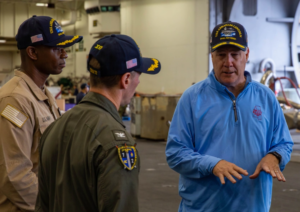Capitol Hill Week Ahead. April 27 couldn’t be any bigger. The House Armed Services Committee will amend the 2017 National Defense Authorization Act, which will be released Monday. On the Senate side, Defense Secretary Ashton Carter and Chairman of the Joint Chiefs of Staff Gen. Joseph Dunford also will testify on the defense budget in front of the defense appropriations subcommittee that day.
DDG 1000 Returns. The USS Zumwalt (DDG-1000) wraps up the at-sea portion of acceptance trials on April 21, spending two days underway. The Navy’s Board of Inspection and Survey (INSURV) demonstrated a range of hull, mechanical and electrical systems including: the boat handling system, anchor system, mooring systems, Integrated Propulsion System including full power demonstration, steering systems, Integrated Fight through Power (IFTP), engineering control system, damage control systems, ballast / deballast systems, navigation systems, internal and external communications systems, total ship computing environment, damage control / firefighting systems, and auxiliary systems. INSURV will now certify that test objectives and requirements have been met before General Dynamics Bath Iron Works delivers the ship.
OneWeb Florida. OneWeb is building an advanced satellite manufacturing facility at Cape Canaveral Spaceport, Fla., slated to open in early 2017, according to a Space Florida statement. Florida Gov. Rick Scott (R) says in a statement the state government permanently eliminates the sales tax on manufacturing machinery and equipment. Space Florida expects the move to bring 250 jobs and $85 million in investment to Florida’s “Space Coast.” OneWeb Satellites is a joint venture, equally owned by OneWeb and Airbus Defence and Space, to design and build the 9,000 satellites of the OneWeb constellation, which will offer high-speed internet with global coverage. OneWeb’s mission is to enable affordable internet to everyone with a constellation of low earth orbit (LEO) satellites, according to Space Florida.
CYBERCOM Staff. Maj. Gen. George Franz III, commanding general of the U.S. Army Intelligence and Security Command (INSCOM), is moving to become director of operations, J-3, for U.S. Cyber Command at Fort Meade, Md. Franz previously serves as commander of the Cyber National Mission Force at Cyber Command before the previous move to INSCOM in May 2014.
Admiral on Board. BAE Systems, Inc., the U.S.-based arm of Britain’s BAE Systems, has appointed retired Navy Adm. Jonathan Greenert to its board of directors for a three-year term. Greenert retired from the Navy last October, with his last six years of service as the chief of naval operations and vice chief of naval operation, respectively. “His experience in management, operations, and strategic planning will be highly valuable,” says Michael Chertoff, chairman of BAE Systems, Inc.’s board.
The Money Trail. The cyber security firm FireEye released a report last week that looks at the cyber criminal group FIN6, tracking the group’s initial intrusion into point-of-sale systems, movement on the network, and finally the selling of stolen payment cards in an underground marketplace. “In this report, we describe FIN6’s tactics, techniques, and procedures, activities, and finally provide a glimpse into the criminal ecosystem that support the ‘payoff’ for their operations,” FireEye says in Follow the Money: Dissecting the Operations of the Cyber Crime Group FIN6.
…Payoff. FireEye says that it identified stolen data—almost 20 million payment cards—from a FIN6-linked breach on an underground card shop. Once the data is posted on the shop, it is quickly purchased to be exploited, with stolen U.S. cards fetching about $21 on average, the report says. If all the data were sold at this price, the value would have been about $400 million, it says. However, FireEye says that because it’s harder to launder stolen cards than it is to steal them, the return would be fraction of the total value.
Hiring Challenges. Customs and Border Protection’s frontline officer needs are more than 2,000 below that that agency’s internal models show it needs, Rep. Martha McSally (R-Ariz.), chairman of the House Homeland Security Border Security Subcommittee, says at the outset of a hearing to examine the agency’s staffing and infrastructure priorities. CBP officials say they are hindered in their hiring by a shortage of federal polygraph examiners, applicant aversion to entrance exams, and no interest by prospective officers in working and living in remote locations.
…Cyber Consequences. The CBP officials also say that a cyber hack of the Office of Personnel Management in 2015 meant that thousands of applications were unavailable during s six-week shutdown and that cyber intrusions in several contractors that do background investigations limited the capacity for investigations to be done. CBP also says they are hampered by “the limited availability of qualified and suitable candidates.”
Space-Based Environmental Monitoring. House authorizers want the Air Force to develop a plan to transfer acquisition and funding authority for covered space-based environmental monitoring missions to the National Reconnaissance Office (NRO) starting in fiscal year 2018, according to the House Armed Services (HASC) strategic forces subcommittee mark released April 19. Lawmakers would restrict money authorized and appropriated for FY ’17 research, development, test and evaluation (RDT&E) to 50 percent until the Air Force submits this plan to appropriate congressional committees. The plan must also include how much money it would take to transfer this authority from the Air Force to the NRO during from FY ’18 to ’22.
NASA ‘Destination Station.’ NASA and the Center for the Advancement of Science in Space (CASIS) held one of their International Space Station (ISS) “Destination Station” industry days in Washington on April 21. The event, hosted by General Assembly; an education company focusing on data, design, business and technology; is one in a series where representatives from the two organizations highlight commercial opportunities ISS provides for researchers. NASA spokeswoman Rachel Kraft says previous Destination Station events in the Washington area took place at Boeing’s Arlington, Va., facility and AstraZeneca in Gaithersburg, Md. Kraft says the next Destination Station event will take place in May in North Carolina’s “Research Triangle,” which generally consists of Raleigh, Durham, Cary and Chapel Hill. Another Destination Station event will take place in July at the ISS Research & Development (R&D) conference in San Diego.
Russ Teehan. Air Force Space Command (AFSPC) chief Gen. John Hyten assigns Col. Russ Teehan as director of the Air Force Research Laboratory (AFRL) space vehicles directorate at Kirtland AFB, N.M., effective June 1. Teehan arrives from the Pentagon where he served as deputy of the intelligence, surveillance and reconnaissance (ISR) systems division. Teehan will lead a team of 809 military, civilian and on-site contractors who comprise the nation’s center of excellence for military space science and technology (S&T), research and development (R&D) as well as advanced technologies integration and demonstration. His organization manages an annual budget of $307 million, focusing on Air Force space missions; communications; position, navigation and timing (PNT); missile warning; space situational awareness (SSA) and defensive counter space, AFRL Commander Maj. Gen. Tom Masiello says via a spokeswoman.
Martin Whelan. Air Force Deputy Chief of Staff for Operations, Director of Future Operations, Maj. Gen. Martin Whelan is retiring Sept. 1, according to the Air Force. He has served in his current position since June 2014. He was previously AFSPC director of requirements and, prior to that, director of operations and nuclear support directorate at the Defense Threat Reduction Agency (DTRA). Whelan was commissioned into the Air Force in 1983 through the ROTC program at St. Louis University. His career includes an initial assignment as an engineer on the space shuttle program.
ITEP. House authorizers want to know if the Army can speed up its Improved Turbine Engine Program (ITEP). The House Armed Services tactical air and land forces subcommittee says in its mark released April 19 that it wants the Army secretary to present a plan by Feb. 15 that lays out potential options for accelerating the development and fielding of the engine. The subcommittee says it recommends $126 million, the amount requested, for the program in fiscal year 2017. ITEP, the Army’s top acquisition priority, is a next-generation engine technology program meant to increase the range and performance of UH-60 Black Hawk and AH-64 Apache helicopters. General Electric and a joint venture of Honeywell and Pratt & Whitney of United Technologies Corp. called ATEC are working on the program.
LRSO. The Ploughshares Fund in a new report calls on President Barack Obama to cancel the Air Force’s new nuclear air-launched cruise missile called Long Range Standoff (LRSO). The anti-nuclear organization says LRSO would have a negative impact on U.S. national security because air launched cruise missiles can come in both conventional and nuclear variants, causing an adversary to miscalculate and launch a nuclear response to a conventional attack. Ploughshares says non-nuclear cruise missiles can perform the same missions as nuclear cruise missiles and, in the extremely unlikely scenario that a nuclear option is needed, the military can call on other nuclear weapons on the arsenal. The group also wants the Air Force to retire its current nuclear Air Launched Cruise Missile (ALCM) once the B-21, or Long Range Strike Bomber (LRSB), is ready.
NASA Contract. Aerojet Rocketdyne defeated Boeing and Space Systems Loral (SSL) for a $67 million cost plus fixed fee NASA contract for thruster and power processing unit development for an advanced electric propulsion system acquisition, according to a source selection statement posted on Federal Business Opportunities (FBO). The request for proposals (RFP) evaluation criteria weighed mission suitability and relevant past performance, when combined, as significantly more important than cost. Aerojet Rocketdyne was rated technically quantitatively and qualitatively superior to the two other proposals. NASA was “especially impressed” with Aerojet Rocketdyne’s effective leveraging of its heritage high-power Hall thruster systems designs. Aerojet Rocketdyne’s proposal also received additional strengths in the technical approach subfactor for an effective approach to modularity and design flexibility. NASA initial evaluation results find that SSL had the lowest probable cost ranking, followed by Boeing and Aerojet Rocketdyne.
CH-53K Award. The Navy on April 18 awarded Sikorsky a $25 million advanced acquisition contract for long-lead items in support of low-rate initial production (LRIP) Lot 1 of two CH-53K aircraft, according to a DoD statement. Work is expected to be completed in October 2021. This contract was not competitively procured. Sikorsky, a Lockheed Martin unit, is developing the CH-53K for the Marine Corps. It achieved first flight in March, pushing fight envelope expansion to 120 knots. The CH-53K is the Marine Corps’ next generation heavy lift helicopter.
Electronic Bid Protest. The Government Accountability Office (GAO) is developing an electronic bid protest filing system and envisions charging $350 per filing, according to an April 15 Federal Register notice. Called Electronic Protest Docketing System (EPDS) it will be the sole means of filing a bid protest at GAO with the exception of protests containing classified information. It will also enable parties to a bid protest and GAO to file and receive documents. The Consolidated Appropriations Act of FY ’14 directs GAO to establish this electronic filing system and also authorizes GAO to collect a fee to support he system. GAO also envisions the EPDS as being the sole means for filing a bid protest. Interested parties must comment by May 16 via email to Jonathan Kang, senior attorney at GAO, at bidprotestregs@gao.gov.
STRATCOM IT. The U.S. Air Force awarded HP a $443 million firm-fixed-price, cost-plus-incentive-fee, cost-reimbursement contract for U.S. Strategic Command Information Technology (IT) Capabilities Contract II. The company will provide performance-based IT services, capabilities, and functions. This includes IT infrastructure, mission critical systems, and applications. The award is the result of a competitive acquisition with five offers received. Fiscal 2016 operation and maintenance funds of $450,000 are obligated at award time. Work is expected to be completed by June 30, 2026 and performed at Offutt AFB, Neb. The contracting activity is the 55th Contracting Squadron at Offutt.
IT Support Contract. The U.S. Navy awarded ManTech Systems Engineering Corp. a nearly $12 million cost-plus-fixed-fee cost-only modification to a previously awarded contract to provide specific systems operation, sustainment, and support services for the Navy Ship Maintenance and Logistics Information Systems (SMLIS) program. It provides uninterrupted enterprise support to the SMLIS program. This includes engineering support for information technology life cycle planning, operations and sustainment, documentation, program management, application technical refresh, testing, training, and deployment. The modification has options that could bring up the total contract value to $47 million. Navy FY ’16 operations and maintenance funds of $4.2 million are obligated at award time and is set to expire at the end of the current fiscal year. Work will mostly be performed in Norfolk, Va. (75 percent); Rocket Center, W.Va. (11 percent); San Diego, Calif. (four percent); and Mechanicsburg, Pa. (three percent). Other areas include Washington, D.C.; Kittery, Maine; Fairfield, Calif.; Hoover, Ala.; New Orleans, La.; and Richmond, Va. Work is expected to finish by July 2017.
DARPA Cyber. The Defense Advanced Research Projects Agency (DARPA) awarded Vencore Labs, acting as Applied Communication Sciences, a nearly $8 million cost-plus-fixed-fee contract for a research project under the Extreme Distributed Denial of Service (DDoS) Defense (XD3) program. The program “seeks to develop revolutionary advances in the area of resilient defenses against [DDoS] attacks on computer networks,” the DARPA announcement says. Over $700,000 in Fiscal 2015 RDT&E funds and $1.4 million 2016 RDT&E funds are obligated at award time. The award is the result of a competitive acquisition under an open broad agency announcement that received 54 proposals. Work is to be performed in Basking Ridge, N.J. (60 percent); Arlington, Va. (34 percent); and Santa Barbara, Calif. (six percent). Completion is expected by April 2009.

 By
By 











